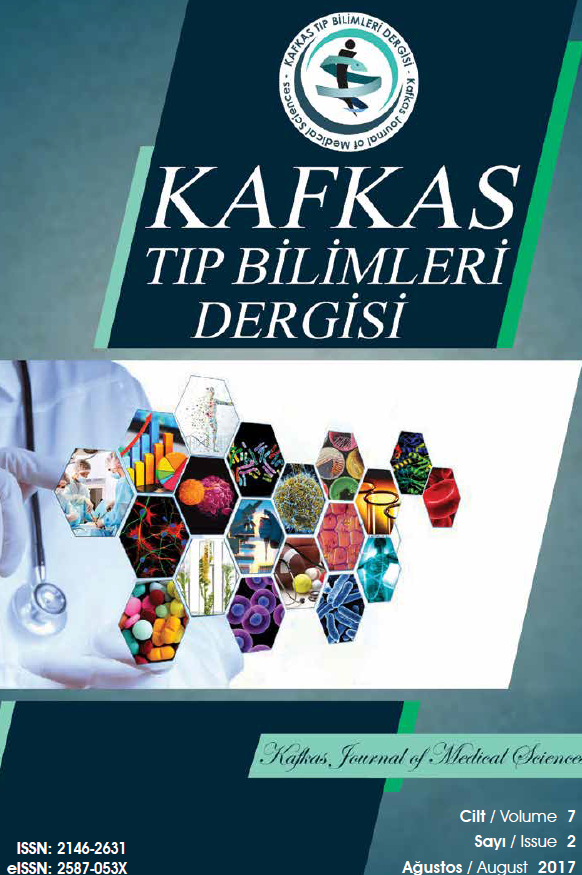Ayak Arkus Açısı ve Ayak Uzunluğu Arasındaki İlişki
medial longitudinal ark, ayak uzunluğu, arcus pedis
Relationship Between the Angle of the Foot Arch and the Length of the Foot
medial longitudinal arch, foot length, foot arch,
___
- 1. Jankowicz-Szymanska A, Mikolajczyk E, Wardzala R. Arch of the foot and postural balance in young judokas and peers. J Pediatr Orthop B 2015; 24(5):456-60.
- 2. Lin CJ, Lai KA, Kuan TS, Chou YL. Correlating factors and clinical significance of flexible flatfoot in preschool children. J Pediatr Orthop 2001; 21(3):378-82.
- 3. Mootanah R, Song J, Lenhoff MW, Hafer JF, Backus SI, Gagnon D, et al. Foot type biomechanics part 2: are structure and anthropometrics related to function? Gait Posture 2013; 37(3):452-6.
- 4. Arıncı K, Elhan A. Anatomi. Ankara: Güneş Kitabevi; 2014:71-128
- 5. Franco AH. Pes cavus and pes planus. Analyses and treatment. Physical Therapy 1987; 67(5):688-94.
- 6. Harris EJ, Vanore JV, Thomas JL, Kravitz SR, Mendelson SA, Mendicino RW, et al. Diagnosis and treatment of pediatric flatfoot. J Foot Ankle Surg 2004; 43(6):341-73.
- 7. Deland JT Adult-acquired flatfoot deformity. Journal of the American Academy of Orthopaedic Surgeons 2008; 16(7):399-406.
- 8. Wozniacka R, Bac A, Matusik S, Szczygiel E, Ciszek E. Body weight and the medial longitudinal foot arch: high-arched foot, a hidden problem? Eur J Pediatr 2013; 172(5):683-91.
- 9. Menz HB. Alternative techniques for the clinical assessment of foot pronation. Journal of the American Podiatric Medical Association 1998; 88(3):119-29.
- 10. Murley GS, Menz HB, Landorf KB. A protocol for classifying normal- and flat-arched foot posture for research studies using clinical and radiographic measurements. J Foot Ankle Res 2009; 2:22.
- 11. Scholz T, Zech A, Wegscheider K, Lezius S, Braumann KM, Sehner S, et al. Reliability and correlation of static and dynamic foot arch measurement in a healthy pediatric population. Journal of the American Podiatric Medical Association 2017; 107(5):419-27.
- 12. Muller S, Carlsohn A, Müller J, Baur H, Mayer F. Static and dynamic foot characteristics in children aged 1-13 years: a cross-sectional study. Gait Posture 2012; 35(3):389-94.
- 13. Yalçın N, Esen E, Kanatlı U, Yetkin H. Medial longitudinal arkın değerlendirilmesi: dinamik plantar basınç ölçüm sistemi ile radyografik yöntemlerin karşılaştırılması. Acta Orthop Traumatol Turc 2010; 44(3):241-5.
- 14. Saltzman CL, Nawoczenski DA, Talbot KD. Measurement of the medial longitudinal arch. Arch Phys Med Rehabil 1995; 76:45-9.
- 15. Pfeiffer M, Kotz R, Ledl T, Hauser G, Sluga M. Prevalence of flat foot in preschool-aged children. Pediatrics 2006; 118(2):634-9.
- 16. Chang JH, Wang SH, Kuo CL, Shen HC, Hong YW, Lin LC. Prevalence of flexible flatfoot in Taiwanese school-aged children in relation to obesity, gender, and age. Eur J Pediatr 2010; 169(4):447-52.
- 17. Mauch M, Grau S, Maiwald C, Horstmann T. Foot morphology of normal, underweight and overweight children. Int J Obes (Lond) 2008; 32(7):1068-75.
- 18. Tenenbaum S, Hershkovich O, Gordon B, Bruck N, Thein R, Darazne E, et al. Flexible pes planus in adolescents: body mass index, body height, and gender--an epidemiological study. Foot Ankle Int 2013; 34(6):811-7.
- 19. Eleswarapu AS, Yamini B, Bielski RJ. Evaluating the Cavus Foot. Pediatr Ann 2016; 45(6):e218-22.
- 20. Vanderwilde R, Staheli L, Chew DE, Malagon V. Measurements on radiographs of the foot in normal infants and children. The Journal of Bone and Joins Surgery 1988; 70-A(3):407-15.
- 21. Uzuner MB, Geneci F, Ocak M, Bayram P, Sancak İT, Dolgun A, et al. Sex determination from the radiographic measurements of calcaneus. Anatomy 2016; 10(3):200-4.
- 22. Redmond AC, Crane YZ, Menz HB. Normative values for the foot posture index. Journal of Foot and Ankle Research 2008; 1(1).
- ISSN: 2146-2631
- Yayın Aralığı: Yılda 3 Sayı
- Başlangıç: 2011
- Yayıncı: Kafkas Üniversitesi
Kronik Otitis Media ve Alerjik Rinit Arasındaki İlişkinin Değerlendirilmesi
Yavuz GÜLER, Rukiye GÜLER, Alper ŞEN, Kadir ÖZDAMAR, Esra AYCAN ÜSTYOL
Muhammet Bora UZUNER, Mustafa Fevzi SARGON, Ferhat GENECİ, Mert OCAK, Tanzer SANCAK, Deniz DEMİRYÜREK, Burak BİLECENOĞLU
Primer Sezaryen Sırasında Adneksial Torsiyon ve İnfundibulo-Pelvik Ligament Yokluğu: Vaka Sunumu
Gülten SAĞIR, Bakiye AKBAŞ, Özgür ÖZDEMİR
Nazofarenks Punch Biyopsi Sonuçlarının Retrospektif Analizi
Selçuk GÜNEŞ, Mustafa ÇELİK, Burak OLGUN, İrem ÖZEN, Hüseyin Avni ULUSOY
Klippel-Feil Sendromu ile Bağlantılı Doğumsal Brakiyal Pleksus Hasarı Olgusu
Yeşim GARİP, Bledjan ÇUNİ, Özgül Bozkurt TUNCER
Muhammed YAYLA, Damla ÇETİN, Çağlar DEMİRBAĞ, Pınar AKSU KILIÇLE
Meme Hastalıkları Miyoma Uteri Birlikteliği
Funda Dinç Elibol, Sezen Bozkurt KÖSEOĞLU
